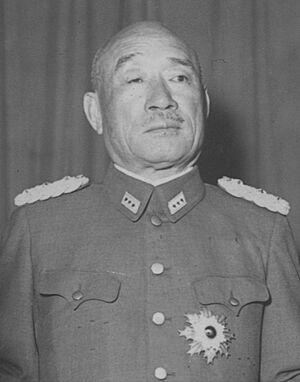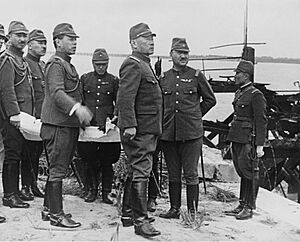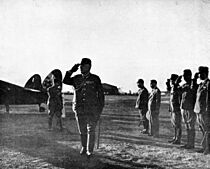Hajime Sugiyama facts for kids
Quick facts for kids
Hajime Sugiyama
|
|
|---|---|
| 杉山 元 | |
 |
|
| Minister of the Army Empire of Japan |
|
| In office 9 February 1937 – 3 June 1938 |
|
| Monarch | Shōwa |
| Prime Minister |
|
| Preceded by | Kōtarō Nakamura |
| Succeeded by | Seishirō Itagaki |
| In office 22 July 1944 – 7 April 1945 |
|
| Prime Minister | Kuniaki Koiso |
| Preceded by | Hideki Tojo |
| Succeeded by | Korechika Anami |
| Chief of the Imperial Japanese Army General Staff |
|
| In office 3 October 1940 – 21 February 1944 |
|
| Monarch | Shōwa |
| Prime Minister |
|
| Preceded by | Prince Kan'in Kotohito |
| Succeeded by | Hideki Tojo |
| Personal details | |
| Born | January 1, 1880 Kokura, Fukuoka Prefecture, Japan |
| Died | September 12, 1945 (aged 65) Tokyo, Japan |
| Awards | Order of the Golden Kite, Order of the Rising Sun |
| Military service | |
| Allegiance | |
| Branch/service | |
| Years of service | 1901–1945 |
| Rank | |
| Commands | 12th Division Northern China Area Army First General Army |
| Battles/wars | Russo-Japanese War
|
Hajime Sugiyama (杉山 元, Sugiyama Hajime / Sugiyama Gen, January 1, 1880 – September 12, 1945) was a very important Japanese military leader. He served as a field marshal for most of the Second World War.
In 1937, as the Army Minister, Sugiyama played a key role in starting the war against China. This happened after an event called the Marco Polo Bridge Incident. Later, in 1940, he became the Army's Chief of Staff. In this role, he strongly supported Japan expanding its power into Southeast Asia. He also pushed for a war against the United States.
When the Pacific War began, Sugiyama was the main commander of the army. He held this position until February 1944. After that, he became Army Minister again in 1944. He served until April 1945. He died shortly after Japan surrendered in September 1945.
Contents
Early Life and Military Training
Hajime Sugiyama was born on January 1, 1880, in Kokura, Japan. His family had a background as samurai, who were ancient Japanese warriors.
He joined the military at a young age. In 1901, he finished his studies at the Imperial Japanese Army Academy. This was a school for future army officers.
Serving in Early Wars
Sugiyama fought as a junior officer in the Russo-Japanese War. This war took place between Japan and Russia. During the Battle of Shaho, he was injured in the face. This injury left scars that made it hard for him to fully open his right eye.
After the war, he continued his education. In 1910, he graduated from the Army Staff College. This college trained officers for important leadership roles.
Spy Missions and Aviation
Sugiyama worked in military intelligence. In 1912, he traveled to the Philippines and Singapore. He pretended to be a civilian working for a trading company. He also visited a US Navy base in the Philippines while disguised as a Japanese Navy officer.
In 1915, he went to British India as a military representative. There, he secretly met with Indian independence leaders. These were people who wanted India to be free from British rule.
He also observed the First World War in the Middle East. After the war, he worked on a committee for military aviation at the League of Nations.
When he returned to Japan, Sugiyama became a leader in military aviation. In 1922, he became the first head of the Imperial Japanese Army Air Service. This showed his strong belief in the importance of airplanes for the army.
Rising Through the Ranks
Army Politics and Influence
In 1924, Sugiyama became a close supporter of Army Minister Ugaki Kazushige. He quickly moved up in the army. By 1925, he was a major general. In 1928, he became the Director of Military Affairs.
Sugiyama was a key member of a group in the army called the Control Faction. This group believed in a strong, modern army controlled by the government.
In 1931, he was involved in the March incident. This was a failed attempt by some military officers to make Ugaki the Prime Minister. Later that year, he publicly defended the army's actions during the Mukden Incident. This event led to Japan taking over parts of China.
Becoming Army Minister
In 1936, Sugiyama was promoted to full general. In February 1937, he became the Army Minister. He served under Prime Minister Senjūrō Hayashi and then under Prime Minister Fumimaro Konoe.
During his time as Army Minister, tensions between Japan and China grew. When fighting broke out near the Marco Polo Bridge, Sugiyama strongly pushed for Japan to fight back against China. This led to the start of the Second Sino-Japanese War.
Leading the Army Staff
After serving as Army Minister, Sugiyama joined Japan's Supreme War Council in 1938. This was a very important group that made big decisions about the war. He also briefly commanded armies in North China and Mongolia.
On September 3, 1940, Hajime Sugiyama became the Chief of the Imperial Japanese Army General Staff. This was one of the highest positions in the Japanese Army.
World War II Leadership
As World War II spread to Asia and the Pacific, General Sugiyama was one of the main army officers who wanted to go to war with Western countries.
On September 5, 1941, Emperor Hirohito questioned Sugiyama. The Emperor reminded him that in 1937, Sugiyama had wrongly predicted that the war in China would end in three months. Despite this, the Emperor eventually approved the decision to go to war on December 1, 1941.
Directing Military Operations
Once the war began, Sugiyama was in charge of directing the army's military plans. In just a few months, Japan conquered many areas in Southeast Asia and the Pacific. These included places like Malaya, the Dutch East Indies, Burma, and the Philippines.
By 1943, the war started to turn against Japan. The Japanese forces suffered big defeats at the battles of Midway and Guadalcanal. In the same year, Sugiyama was given the special honorary rank of field marshal.
As the war continued to go badly for Japan, Sugiyama was removed from his role as Chief of the General Staff on February 21, 1944. General Hideki Tōjō took over his position. Sugiyama was then appointed to a very respected role as Inspector-general of Military Training.
After Tōjō was removed from power in 1944, Sugiyama became Army Minister again. He served in the new government of Prime Minister Kuniaki Koiso. In July 1945, he was asked to command the First General Army. This army was responsible for defending the eastern part of Japan against an expected invasion by the Allied Powers.
Sugiyama died on September 12, 1945, ten days after Japan surrendered. He was preparing for the final end of the Imperial Japanese Army. His grave is located at the Tama Cemetery in Fuchū, Tokyo.
Images for kids





